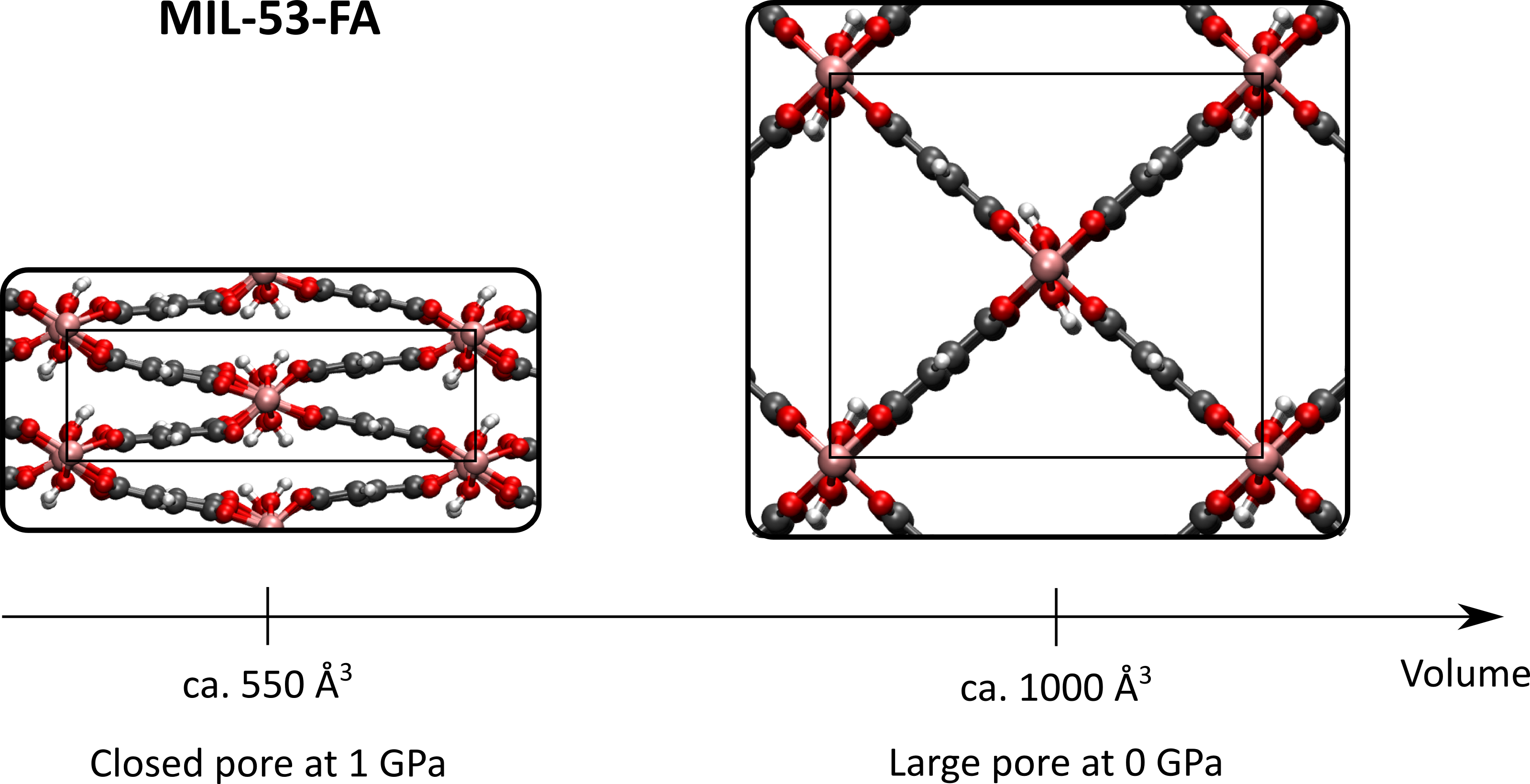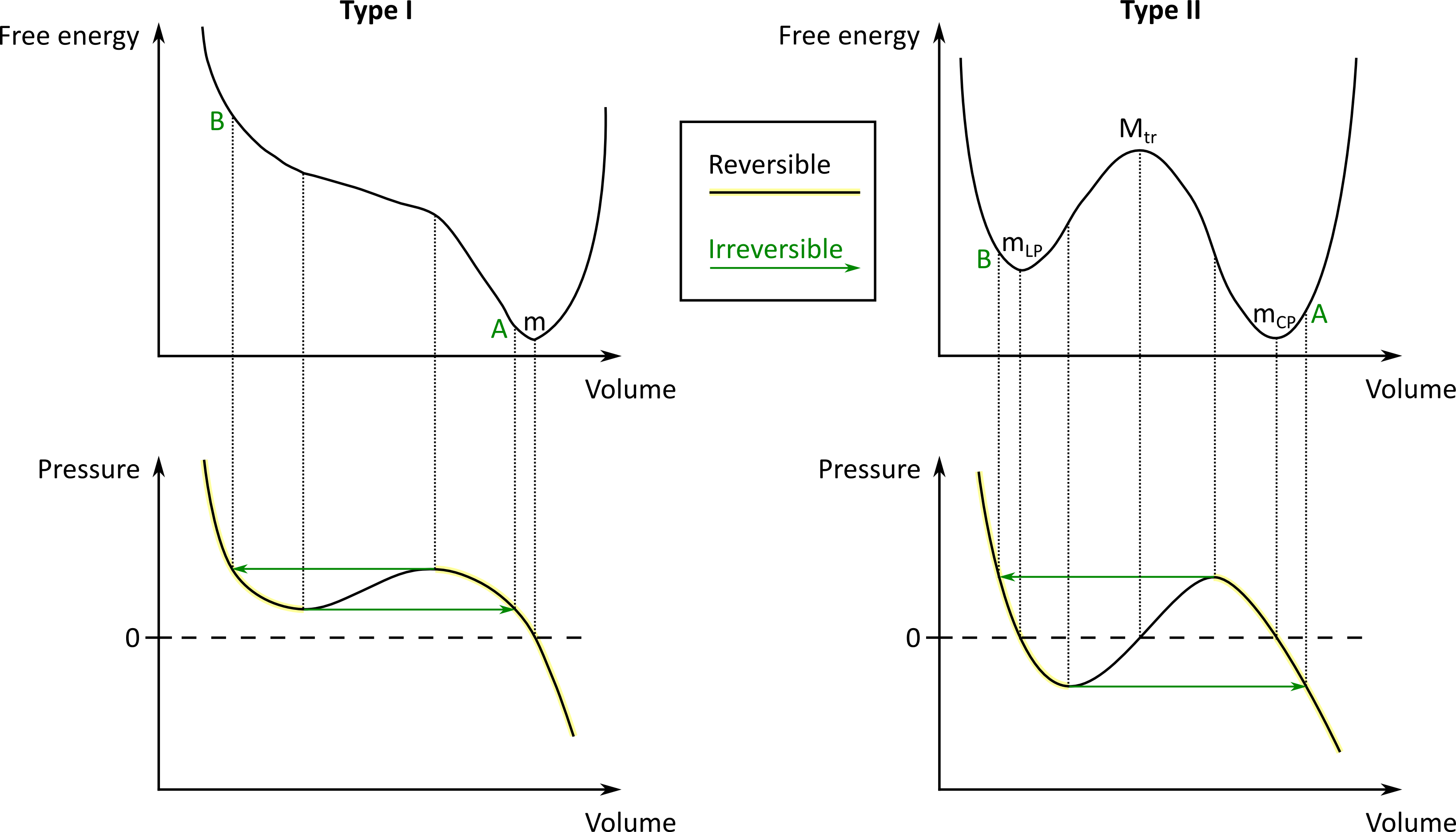Application of flexible metal-organic frameworks as nanosized shock absorbers
Application of flexible metal-organic frameworks as nanosized shock absorbers
Promotor(en): V. Van Speybroeck /16NANO13 / Nanoporous materialsSince their discovery about two decades ago, metal-organic frameworks (MOFs) have emerged in a plethora of applications. MOFs, a class of hybrid materials composed of organic ligands linking inorganic moieties, are renowned for their versatility and nanoporosity. As a consequence, they are now used in gas storage and separation, drug delivery, sensing applications, etc. Moreover, some of these materials, e.g. MIL-53-FA, exhibit large-amplitude transformations between two metastable phases: a large-pore and a closed-pore phase, the latter being smaller in volume (see figure 1) [1]. These transformations, which can be induced by gas adsorption, temperature or pressure, are associated with a change in free energy of the system. Based on thermodynamics, if the change in free energy is positive, hence if the closed-pore metastable state is less stable than the large-pore state, work needs to be added to the system. Or, the other way around, if the large-pore material is subject to a sudden shock, part of the work performed by that shock on the material will be absorbed thanks to the transformation to the closed-pore phase. These materials are thus expected to play an increasingly important role in nanosized shock absorbing applications. However, due to the large versatility of MOFs, a consequence of the large number of potential inorganic bricks and organic ligands, an experimental characterization of all candidates is unfeasible.

Goal
In this thesis, a set of potential MOF candidates will be screened for their application as nanosized shock absorbers, to limit the number of viable materials that need to be assessed experimentally. This screening consists of two parts. First, we will determine for each MOF the pressure it can withstand at every volume (see figure 2 (bottom)), following a recently published in-house methodology [2]. For flexible MOFs, there exists a range of pressures for which multiple (meta)stable states can be found. This means that, when a pressure within this range is applied, two possible phases can be obtained, depending on the phase before the pressure treatment. When the pressure is sufficiently high, i.e. above the aforementioned pressure range, no large-pore phase can be sustained, and the material shrinks to its closed-pore phase, accompanied with a decrease in volume. Hence, after this first step, we can define the volume before and after the application of the shock. Second, the free energy profile accompanying the pressure profile will be derived, based on thermodynamic integration (see figure 2 (top)). This free energy profile will reveal the relative stability of the closed-pore phase with respect to the large-pore phase, . This free energy difference determines a lower bound of the energy that can be absorbed by the MOF. Indeed, if work
 is performed on the system, thermodynamics stipulates that the following equation needs to hold:
is performed on the system, thermodynamics stipulates that the following equation needs to hold:
where
 is the change in entropy of the universe. This quantity is always positive, and only zero if the process is completely reversible. Hence, in our case study on the absorption of shocks, the free energy difference will yield a lower bound of the energy absorbed during the shrinking process. It is exactly this quantity that we will compare between different MOFs. Moreover, limited experimental input is also available to validate this methodology [1].
is the change in entropy of the universe. This quantity is always positive, and only zero if the process is completely reversible. Hence, in our case study on the absorption of shocks, the free energy difference will yield a lower bound of the energy absorbed during the shrinking process. It is exactly this quantity that we will compare between different MOFs. Moreover, limited experimental input is also available to validate this methodology [1].
In the methodology outlined above, molecular dynamics simulations will be performed to obtain the pressure and free energy profiles. During these simulations, the Newtonian equations of motion are integrated, mimicking the effective dynamics of the system. These equations require the calculation of the force at each simulation step. Since this is computationally too demanding to do quantum mechanically, force fields will be used. In a force field, the quantum mechanical potential energy surface is approximated by an analytic expression, which is much faster to evaluate. During the past few years, force fields were derived at CMM for a small set of potentially interesting materials, which can be used as a starting point. However, in a later stage, the student will have to build new MOFs by combining linkers and inorganic bricks that performed well during the first stage. For these new materials, force fields need to be developed using QuickFF, an in-house software package. Hence, at the end of the thesis year, the student should be able to answer which combination of linkers and inorganic bricks yields the best shock absorber.
The Center for Molecular Modeling has ample expertise in modeling nanoporous materials, especially MOFs, and performs this research in the framework of large-scale international research programs. The modeling is performed in close collaboration with experimental partners to achieve an optimal synergy between modeling and experimental efforts. The student will be actively involved in the work discussions with these national and international prominent partners. Furthermore, the student will be actively coached to get acquainted with all necessary techniques to perform the suggested research successfully.
Aspects
Physics aspect: Derivation of accurate force fields, application of thermodynamics.
Engineering aspect: Computational screening of materials for their application as nanosized shock absorbers.
- Study programmeMaster of Science in Engineering Physics [EMPHYS], Master of Science in Physics and Astronomy [CMFYST]ClustersFor Engineering Physics students, this thesis is closely related to the cluster(s) NANO, MODELINGKeywordsFlexibility, Thermodynamics, Force fields, Molecular dynamics, Metal-organic frameworks, nano shock absorberReferences
[1] P. G. Yot, L. Vanduyfhuys, E. Alvarez, J. Rodriguez, J.-P. Itié, P. Fabry, N. Guillou, T. Devic, I. Beurroies, L. P. L., V. Van Speybroeck, C. Serre and G. Maurin, "Mechanical energy storage performance of an aluminum fumarate metal-organic framework," Chem. Sci., vol. 7, no. 1, pp. 446-450, 2016.
[2] S. M. J. Rogge, L. Vanduyfhuys, A. Ghysels, M. Waroquier, T. Verstraelen, G. Maurin and V. Van Speybroeck, "A comparison of barostats for the mechanical characterization of metal-organic frameworks," J. Chem. Theory Comput., vol. 11, no. 12, pp. 5583-5597, 2015.


 is performed on the system, thermodynamics stipulates that the following equation needs to hold:
is performed on the system, thermodynamics stipulates that the following equation needs to hold:
 is the change in entropy of the universe. This quantity is always positive, and only zero if the process is completely reversible. Hence, in our case study on the absorption of shocks, the free energy difference will yield a lower bound of the energy absorbed during the shrinking process. It is exactly this quantity that we will compare between different MOFs. Moreover, limited experimental input is also available to validate this methodology [1].
is the change in entropy of the universe. This quantity is always positive, and only zero if the process is completely reversible. Hence, in our case study on the absorption of shocks, the free energy difference will yield a lower bound of the energy absorbed during the shrinking process. It is exactly this quantity that we will compare between different MOFs. Moreover, limited experimental input is also available to validate this methodology [1].